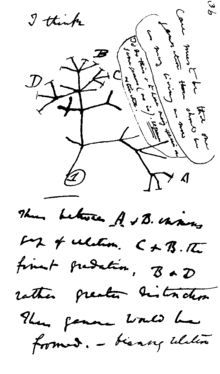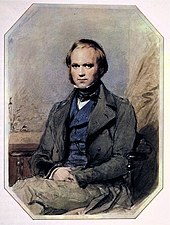Charles Lyell eagerly met Darwin for the first time on 29 October and soon introduced him to the up-and-coming anatomist Richard Owen, who had the facilities of the Royal College of Surgeons to work on the fossil bones collected by Darwin. Owen's surprising results included other gigantic extinct ground sloths as well as the Megatherium, a near complete skeleton of the unknown Scelidotherium and a hippopotamus-sized rodent-like skull named Toxodon resembling a giant capybara. The armour fragments were actually from Glyptodon, a huge armadillo-like creature as Darwin had initially thought.These extinct creatures were related to living species in South America.
In mid-December Darwin took lodgings in Cambridge to organise work on his collections and rewrite his Journal.He wrote his first paper, showing that the South American landmass was slowly rising, and with Lyell's enthusiastic backing read it to the Geological Society of London on 4 January 1837. On the same day, he presented his mammal and bird specimens to the Zoological Society. The ornithologist John Gould soon announced that the Galapagos birds that Darwin had thought a mixture of blackbirds, "gros-beaks" and finches, were, in fact, twelve separate species of finches. On 17 February Darwin was elected to the Council of the Geological Society, and Lyell's presidential address presented Owen's findings on Darwin's fossils, stressing geographical continuity of species as supporting his uniformitarian ideas.
Early in March, Darwin moved to London to be near this work, joining Lyell's social circle of scientists and experts such as Charles Babbage,who described God as a programmer of laws. Darwin stayed with his freethinking brother Erasmus, part of this Whig circle and close friend of writer Harriet Martineau who promoted Malthusianism underlying the controversial Whig Poor Law reforms to stop welfare from causing overpopulation and more poverty. As a Unitarian she welcomed the radical implications of transmutation of species, promoted by Grant and younger surgeons influenced by Geoffroy. Transmutation was anathema to Anglicans defending social order, but reputable scientists openly discussed the subject and there was wide interest in John Herschel's letter praising Lyell's approach as a way to find a natural cause of the origin of new species.
Gould met Darwin and told him that the Galápagos mockingbirds from different islands were separate species, not just varieties, and what Darwin had thought was a "wren" was also in the finch group. Darwin had not labelled the finches by island, but from the notes of others on the Beagle, including FitzRoy, he allocated species to islands.The two rheas were also distinct species, and on 14 March Darwin announced how their distribution changed going southwards.

In mid-July 1837 Darwin started his "B" notebook on Transmutation of Species, and on page 36 wrote "I think" above his first evolutionary tree.

0 comments:
Post a Comment